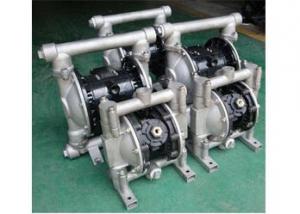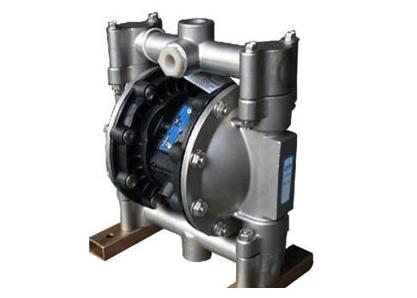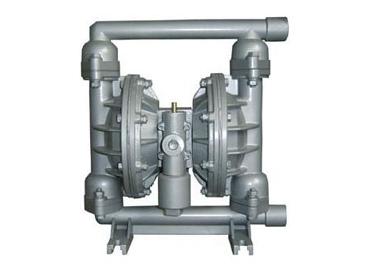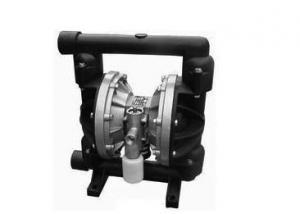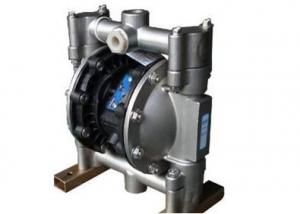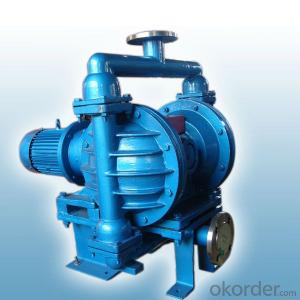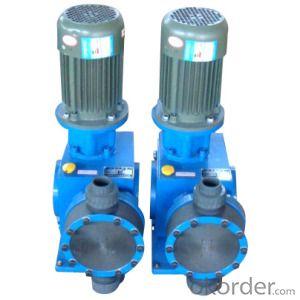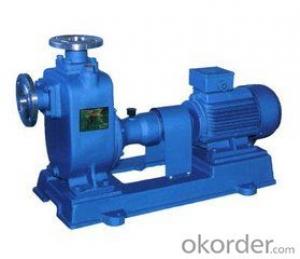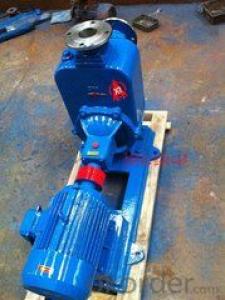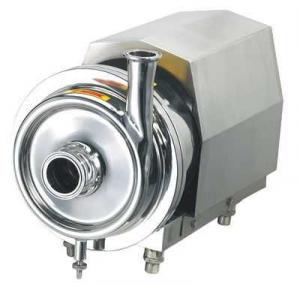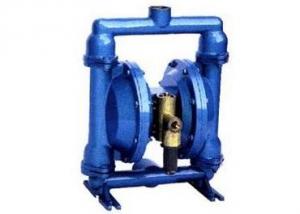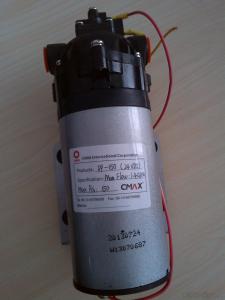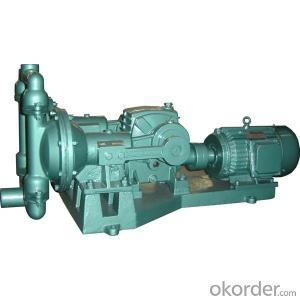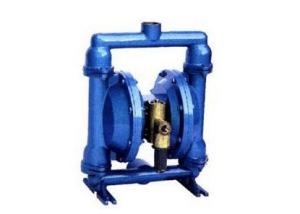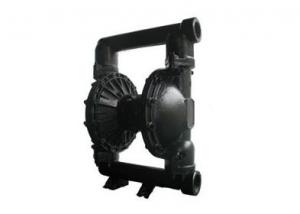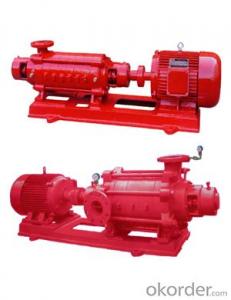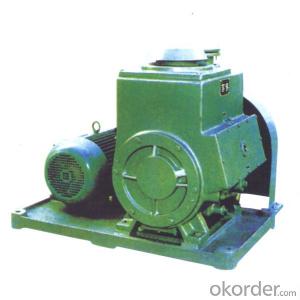Stainless Steel Diaphragm Pump
- Loading Port:
- China Main Port
- Payment Terms:
- TT or LC
- Min Order Qty:
- 1 unit unit
- Supply Capability:
- 1000 Per Month unit/month
OKorder Service Pledge
OKorder Financial Service
You Might Also Like
Details for Powder Diaphram Pump
1, Package and delivery of Stainless Steel Diaphram Pump
1) Packed with standard exporting wooden case, requested package will be acceptable.
2) Delivery date will be within 30 days after receiving the prepayment.
2, Technical specification of Stainless Steel Diaphram Pump
|
Working Principle: |
Double Diaphragms |
|
Main applications: |
Oil, Water, Chemical, Foodstuff, etc. |
|
Driver: |
Air operated (Penumatic) |
|
Power Specs: |
380/415 V 3phase; 50hz/60hz etc. |
|
Max. permissible fluid temperature: |
150°C |
|
Type of connection: |
Flange, Thread, Quick Coupled. |
|
Installation position: |
Connect to compressor |
|
Casing/Inner parts material: |
C.I, S.S, PP, Aluminium /PP, PTFE, PVDF. |
|
Shaft seal type: |
O-rings in pump |
|
Free passage: |
3mm-10mm |
|
Maximum viscosity: |
5X104CST |
|
Maximum drive rating: |
0.2-0.7mpa (2-7bar) |
|
Maximum caliber: |
4 inch (100mm) |
|
Maximum dischrage head: |
0.5mpa (5bar) |
|
Flow rate range: |
0.8-40 m³/h (13.3-667l/m) |
3, The features about Stainless Steel Diaphram Pump
1) High temperature wax casting, heat treatment and shaping processing. Smooth surface and good appearance.
2) Liquid chamber and manifold adopt 4 bolt connection. Good seal, the actal dry suction can reach to 4~7m.
3) Origin stainless steel color. The pump surface adopt pickling and electrolytic processing.
4) We can supply stainless steel 304 /316 pump from 1/2" to 3".
5) The bolts of stainless steel pump are of Stainless steel 304.
4, The advantages about our Stainless Steel Diaphram Pump
1) Four bolts connection with very round ball, well seal and good dry suction. The actual dry suction can reach to 4~7m.
2) High roundness valve ball for use the ball mill machine.
3) Three section manifold, Flexible installation and even can simultaneously convey two different liquids.
4) Longer diaphragm life. Diaphragm material from Dopont, Exxon.
5) Pilot type air valve, low maintenance, low air consumption, so the using cost is low.
6) Wetted body: PPH, PVDF, SS304, SS316, Aluminum etc.
7) Diaphragm: PTFE, Hytrel, Santoprene, Viton etc.
- Q: Can an air pump be used for inflatable pet accessories?
- Yes, an air pump can be used for inflatable pet accessories such as pet beds, toys, or floatation devices. It provides a convenient and efficient way to inflate these accessories, ensuring they are properly filled and ready for use.
- Q: Are there air pumps suitable for industrial applications?
- Yes, there are air pumps specifically designed for industrial applications. These air pumps are built to handle the demands of heavy-duty industrial use, where large volumes of air need to be pumped continuously. They are typically more powerful and durable compared to air pumps used for residential or commercial purposes. Industrial air pumps are capable of generating high-pressure air and can be used in various applications such as pneumatic tools, manufacturing processes, air compressors, HVAC systems, and wastewater treatment plants. They are engineered to withstand harsh environments, operate at high temperatures, and have longer service life. Additionally, they usually come with advanced features like variable-speed drives, energy efficiency, and remote monitoring to optimize performance and reduce operational costs.
- Q: Can an air pump be used for powering air rifles?
- Absolutely! Air rifles can indeed utilize an air pump for their power source. The functionality of air rifles revolves around the utilization of compressed air, and an air pump is a widely employed technique to achieve this compression. By employing the pump, one can fill a reservoir with compressed air, which is subsequently discharged to forcefully propel the pellet or bullet from the rifle's barrel. Manual operation of the pump is required, necessitating physical exertion to generate the requisite air pressure. Consequently, individuals without access to alternative power sources like CO2 cartridges or compressed air tanks may find this method particularly convenient.
- Q: Does the high pressure air function replace the air pump?
- High pressure fan air flow, but the pressure is not enough, can not replace the air pump.
- Q: How does an air pump handle different air humidities?
- An air pump is designed to effectively move air, regardless of its moisture content, in order to handle different air humidities. The humidity level in the air does not affect the operation of the air pump. The main purpose of an air pump is to generate airflow. This is accomplished by utilizing a motor or a piston within the pump to create pressure differences that push the air out of the pump. The air pump works by compressing the air, which then forces it out of the pump. Regardless of the humidity level, air molecules are still present and can be compressed to generate pressure. The air pump does not distinguish between dry or humid air and is able to compress and move it with equal efficiency. However, it is important to consider that the humidity level of the air being pumped may have an impact on the overall environment in which the pump is being used. If the pump is utilized for tasks such as inflating air mattresses or operating air-powered tools, the moisture content in the air could affect the performance or functionality of these devices. In such situations, it may be necessary to employ additional equipment like moisture filters or dryers to eliminate excess moisture from the air before it enters the pump. In conclusion, the primary function of an air pump is to move air molecules, regardless of their moisture content, and is not directly influenced by different air humidities. However, for specific applications, the impact of humidity should be taken into account to ensure optimal performance and prevent potential damage to equipment.
- Q: Can an air pump be used for deflating objects?
- No, an air pump cannot be used for deflating objects as its purpose is to inflate or provide air pressure to objects.
- Q: How to properly store an air pump when not in use?
- When not in use, it is important to properly store an air pump to ensure its longevity and functionality. Start by disconnecting the pump from any power source. Clean the pump thoroughly to remove any dirt or debris that may have accumulated. Next, ensure that all attachments or hoses are detached and stored separately. Store the pump in a cool, dry place, away from direct sunlight and extreme temperatures. It is advisable to use the original packaging or a protective cover to prevent any damage or dust accumulation. Regularly check the pump for any signs of wear or damage, and if necessary, service or repair it before using it again.
- Q: Can an air pump be used for inflatable advertising walls?
- Yes, an air pump can be used for inflatable advertising walls. In fact, it is the most common method used to inflate these types of structures quickly and efficiently. Air pumps are designed to provide a continuous flow of air into the inflatable wall, which helps it maintain its shape and stability. The size and power of the air pump will depend on the specific dimensions and requirements of the advertising wall. It is important to select an air pump that is compatible with the inflatable advertising wall to ensure proper inflation and optimal performance.
- Q: Can an air pump be used for waste water treatment?
- No, an air pump cannot be used for waste water treatment as it is primarily used for providing aeration in aquariums and fish tanks. Waste water treatment requires complex processes and equipment such as sedimentation tanks, filtration systems, and chemical treatments to effectively remove contaminants and impurities from the wastewater.
- Q: What is the ideal air pressure for hydroponic systems?
- The air pressure needed for hydroponic systems can vary depending on the setup and the plants being grown. Most hydroponic systems typically require a pressure between 5 and 10 psi (pounds per square inch) to ensure proper oxygenation and nutrient delivery to the plant roots. However, it's important to consider that the specific air pressure requirements may differ based on factors like the type of hydroponic system and the plants being cultivated. For instance, certain plants, like lettuce, thrive in higher levels of oxygen and may benefit from higher air pressure. To determine the ideal air pressure for a hydroponic system, it's recommended to consult the manufacturer's guidelines or seek advice from experienced hydroponic growers. Regular monitoring of the system's oxygen levels and plant health can also help identify if any adjustments in air pressure are needed.
Send your message to us
Stainless Steel Diaphragm Pump
- Loading Port:
- China Main Port
- Payment Terms:
- TT or LC
- Min Order Qty:
- 1 unit unit
- Supply Capability:
- 1000 Per Month unit/month
OKorder Service Pledge
OKorder Financial Service
Similar products
Hot products
Hot Searches
Related keywords
